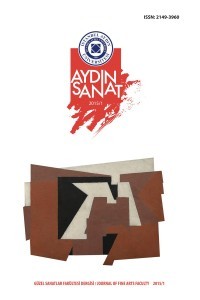Sanatçı İmgesinin Kurulumu
Efsane, Mit ve Büyü: Sanatçı İmgesinin Doğuşu adlı çığır açıcı kitaplarında Ernst Kris ve Otto Kurz,çağlar boyunca sanatçı imgesinin doğuşunu, erken dönem biyografi yazarları ve sanat tarihçilerininçalışmalarında da gözlemlenen sanatçılar hakkındaki spekülasyonlar ve söylencelerle ele almışlardı.Modern kapitalizme kadar “sanat” ve “sanatçı” kavramları tartışmalı ve şüpheli olgular değillerdi.Modern çağ boyunca “sanatsal deha”nın “şöhret”e evirilmesi sanat eleştirisi ve sanat tarihi içindeen tartışmalı konularından biri olageldi. Günümüz sanatını küratörler, kurumlar, müzeler, sanateleştirmenleri ve sanatçılar gibi kültür aktörlerinin birlikte hareket ettikleri eğlence endüstrisindenbağımsız değerlendirmek neredeyse olanaksız. Şimdilerde eskinin “kutsal sanatçı, yüce ve deha” gibikavramları, gündelik hayat ve nihayetinde eğlence endüstrisinin içinde ucuz popülizm ve modanınaltına çekilmiş durumda. Böylesi bir değişim bizlerin çağdaş sanatı algılayışımızı biçimlendiriyor,hatta tümden hak etmese de onu itibarsızlaştırmamıza bile yol açıyor.
Anahtar Kelimeler:
Deha, Şöhret, Eğlence Endüstrisi, Vurucu İş
Establishing The Artistic Image
In their groundbreaking book “Legend, Myth and Magic in the Image of the Artist” Ernst Kris and OttoKurz dwelt upon the evolvement and the creation of the image of an artist throughout the ages withspeculations and anecdotes on artists developed by early biography writers and art historians. Until themodern capitalism, the concepts of “art” and “artist” were not controversial or suspicious phenomena.During the modern age, the transformation of “artistic genius” into a “celebrity” has become one of themost controversial issues in both art criticism and art history. Today’s art cannot almost be consideredwithout entertainment industry, where art and culture actors including curators, institutions, museums,art critics and artists, act together sometime deliberately or inevitably. Recently, the old concepts suchas the divina artista, sublime and genius seem to have been dragged into celebrity; cheap populism andfashion intertwined with daily life and subsequently entertainment industry. This kind of change shapesthe way we perceive contemporary art, and sometimes even leads us to denigrate contemporary artalthough it does not deserve it entirely.
Keywords:
Genius, celebrity, entertainment industry, shocking work,
___
- Artun, A., (2015), Bir Muamma: Sanat Hayat, Aforizmalar, İstanbul: İletişim Yayınları.
- Bard, A. ve Söderqvist J., (2012), Fütürika Üçlemesi, çev: Melin Tümen, İzmir: Kara Kalem Yayınları.
- Elia M. ve Elia E., (2015). We Go To The Gallery, London: Dung Beetle New Words Reading Scheme, Dung Beetle.
- Foster, H., (2008). Kültürel Direniş, çev: Elçin Gen, Sanat Siyaset, Editör: Ali Artun, İstanbul: İletişim Yayınları.
- Gielen, P., (2016). Sanatsal Çokluğun Mırıltısı, çev: Albina Ulutaşlı, İstanbul: Norgunk Yayınları.
- Groys, B., (2008), A Genealogy of Participatory Art, The Art of Participation: 1950 Up To Now, London: Thames and Hudson.
- Kuspit, Donald. (2006). Sanatın Sonu, çev: Yasemin Tezgiden, İstanbul: Metis Yayınları.
- Kurz, O., Kris E., (2013). Sanatçı İmgesinin Doğuşu: Efsane, Mit, Büyü, çev: Sabri Gürses, İstanbul: İthaki Yayınları.
- Steyerl ,H., (2013). Sanatın Politikası: Çağdaş Sanat ve Post-Demokrasiye Geçiş, çev: Zeynep Barensel.
- Siegel, K.- Mattick, P., (2004). Money, London: Thames and Hudson.
- Toksöz, E., (2015). Contemporary Art and Entertainment Industry, İstanbul: (Yayınlanmamış Yüksek Lisans Tezi), Yeditepe Üniversitesi Sosyal Bilimler Enstitüsü.
- Perniola, M., (2015). Sanat ve Gölgesi, çev: Kemal Atakay, İstanbul: İletişim Yayınları.
- Thompson, N., (2018). İktidarı Görmek, çev: Erden Kosova, İstanbul: Koç Üniversitesi Yayınları.
- Thornton, S., (2009). Seven Days in The Art World, London: Granta Publications.
- ISSN: 2149-3960
- Yayın Aralığı: Yılda 2 Sayı
- Başlangıç: 2015
- Yayıncı: İstanbul Aydın Üniversitesi
Sayıdaki Diğer Makaleler
Değirmen ve Haç (2011) Filmi Ekseninde Teknoloji ve Sanat İlişkisi
MirrorMask Filmi Üzerinden Anne-Kız Çocuğu İlişkisinin İncelenmesi
Sinemanın Propaganda Aracı Olarak Kullanılması: Ben Küba Filmi
Dijital Teknoloji ve Grafik Tasarımda Yenilikler
Sanat Tarihinin Temel Kavramları ve Bir Metin Eleştirisi
